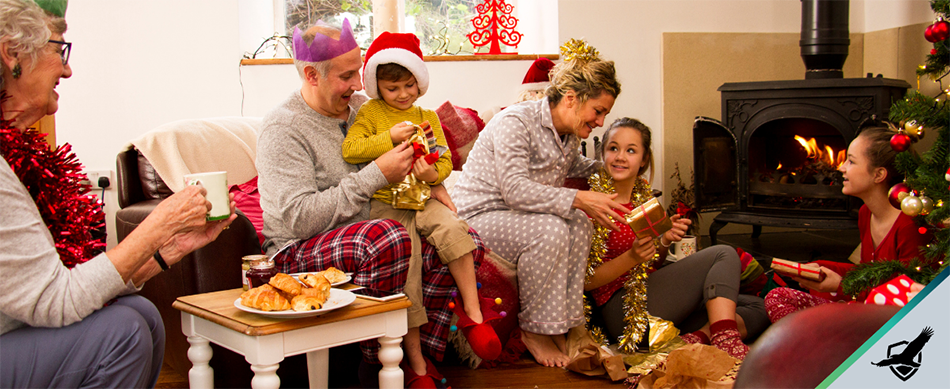Holiday Fire Prevention Tips to Keep Spirits Festive

Mmmmmm, eggnog and sugar cookies! Don’t let treats distract you from putting up decorations. Your giant, inflatable Rudolph will look great next to Darth Vader. The reindeer’s nose matches the Sith lord’s lightsaber, but you can avoid the wrong shade of red with these holiday fire prevention tips.
Thanksgiving is the only day with more reported home cooking fires than Christmas and Christmas Eve. (Source: National Fire Protection Agency [NFPA])
Start in the Kitchen
How long should you cook the ham? Does the chocolate pie filling need more sugar?
You could get lost in a maze of recipes. If you have food in the oven, don’t leave your house.
You think about folding laundry in another room, but don’t step out of the kitchen when the stove burners are on.
Keep your stove and oven clean and free of grease build-up, too. You might say, “Well, the oven self-cleaning function doesn’t really work, and it smells terrible.”
We hear that.
It’s easy to clean your oven with nothing more than:
Baking sodaA wet dish cloth or ragA plastic spatulaRubber glovesA spray bottleWaterWhite vinegar
Visit kitchen for more details on this easy cleaning process.
Don’t use power strips or extension cords for major appliances like your oven. Plug them directly into the wall, and leave small appliances unplugged when not in use.
Accidents happen, even when you pay attention and take the right steps. That’s why you should store a fire extinguisher in your kitchen.
Don’t keep it in a place near the oven because that’s where most fires start. Think about storing it in an easy-to-access cabinet.
When a fire breaks out, get your fire extinguisher and use the U.S. Fire Administration’s PASS method:
Pull the pin. Point the extinguisher away from you and pull the locking pin.Aim. Point the extinguisher toward the base of the fire.Squeeze. Squeeze the lever to activate the fire extinguisher.Sweep. Spray the extinguisher in a side-to-side motion to cover the base of the fire.
Between 2013 and 2017, U.S. fire departments responded to an average of 780 yearly home fires that started with decorations. (Source: NFPA)
Let the Living Room Shine in Safety
Think about all the decorations you could use to deck out your living room:
CandlesGarlandsOrnamentsPoinsettiasRibbonsWreaths
Don’t let these lovely decorations turn into fire hazards. Keep them at least three feet away from fireplaces and space heaters.
Turn space heaters off when you leave the room.
Don’t run electrical cords underneath rugs, and don’t overload circuits or extension cords, power strips, and outlets.
Between 2013 and 2017, U.S. fire departments responded to a yearly average of 160 home fires that started with Christmas trees. (Source: NFPA)
Your Tree Needs to Drink (Unless It’s Fake)
Think about the main conditions that cause forest fires:
Dry vegetationHeatHumans: A single match could ignite a flame that destroys thousands of acres.
So why would you bring a real tree home, set it in your living room, and let it go dry?
Water your tree! And while you’re at it, keep it at least three feet away from sources of heat.
Always unplug lights before leaving your house or going to sleep, and throw away frayed and pinched wires.
But what about fake trees?
You might want to avoid pre-lit trees because the wiring could go bad and cause a fire.
If you choose a “normal” fake tree, make sure you buy one that isn’t flammable. The box should have this info.
22 home candle fires happened every day from 2013 to 2017. (Source: NFPA)
Odds and Ends Around the House
Here’s some more advice to keep your home safer during the holiday season:
Real candles look great, but they don’t make safe decorations.Consider replacing traditional candles with LED candles.Store matches and lighters in a secure location, especially if you have children.If you smoke, do it outside the home. Or quit altogether as a present to yourself.Put smoke detectors on each level of your home, including the basement, every bedroom, and halls by those bedroomsPut carbon monoxide detectors on every level of the house, placed five feet from the ground and near every sleeping area.Have your furnace inspected twice per year. One of those inspections should happen during the fall to prepare the system for winter.







